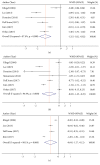Blood Lactate or Lactate Clearance: Which Is Robust to Predict the Neurological Outcomes after Cardiac Arrest? A Systematic Review and Meta-Analysis
- PMID: 30370306
- PMCID: PMC6189651
- DOI: 10.1155/2018/8014213
Blood Lactate or Lactate Clearance: Which Is Robust to Predict the Neurological Outcomes after Cardiac Arrest? A Systematic Review and Meta-Analysis
Abstract
Aims: Lactate and lactate clearance were supposed to be associated with cardiac arrest outcomes, but studies obtained different results. Thus, we conducted this meta-analysis to investigate the association between lactate or lactate clearance and neurological outcomes and their usefulness for prediction of neurological outcomes.
Methods: We conducted a systematic search in PubMed, Web of science, EMBASE, Medline, and Google Scholar until May 1, 2018, for relevant studies. Studies reporting lactate, lactate clearance on admission, or other time points after admission associated with neurological outcomes were included in our analysis. Pooled effect date was shown as weighed mean difference (WMD) and 95% confidence interval (CI). To measure the usefulness of lactate on admission to predict neurological outcomes, we also pooled the data of diagnostic test.
Results: 23 studies involving 6720 cardiac arrest (CA) patients were included. Results from our analysis indicated that patients with good neurological outcomes tended to have a lower lactate level on admission (WMD: -2.66 mmol/L, 95%CI: -3.39 to -1.93) and 12h, 24h, and 48h after admission (P<0.001). Furthermore, the pooled AUC for lactate level on admission to predict neurological outcomes was 0.77 (95%CI: 0.73-0.80). However, a significant association between lactate clearance and neurological outcomes was only found in 24h but not 12h lactate clearance rate.
Conclusions: Lactate levels on admission and all time points up to 48h were associated with neurological outcomes after CA, whereas the association between lactate clearance and neurological outcomes was not so stable. Lactate was a more robust surrogate marker than lactate clearance to predict neurological outcomes after CA.
Figures





Similar articles
-
Serial lactate determinations for prediction of outcome after cardiac arrest.Medicine (Baltimore). 2004 Sep;83(5):274-279. doi: 10.1097/01.md.0000141098.46118.4c. Medicine (Baltimore). 2004. PMID: 15342971
-
Association of serum biomarkers with outcomes of cardiac arrest patients undergoing ECMO.Am J Emerg Med. 2018 Nov;36(11):2020-2028. doi: 10.1016/j.ajem.2018.03.015. Epub 2018 Mar 10. Am J Emerg Med. 2018. PMID: 29559353
-
Better lactate clearance associated with good neurologic outcome in survivors who treated with therapeutic hypothermia after out-of-hospital cardiac arrest.Crit Care. 2013 Oct 31;17(5):R260. doi: 10.1186/cc13090. Crit Care. 2013. PMID: 24172276 Free PMC article.
-
Effective lactate clearance is associated with improved outcome in post-cardiac arrest patients.Resuscitation. 2007 Nov;75(2):229-34. doi: 10.1016/j.resuscitation.2007.03.021. Epub 2007 Jun 20. Resuscitation. 2007. PMID: 17583412
-
A systematic review and meta-analysis: The effects of probiotic supplementation on metabolic profile in patients with neurological disorders.Complement Ther Med. 2020 Sep;53:102507. doi: 10.1016/j.ctim.2020.102507. Epub 2020 Jul 15. Complement Ther Med. 2020. PMID: 33066850
Cited by
-
Association between Early Phase Serum Albumin Levels and Outcomes of Post-Cardiac Arrest Patients: A Systematic Review and Meta-Analysis.J Pers Med. 2022 Oct 29;12(11):1787. doi: 10.3390/jpm12111787. J Pers Med. 2022. PMID: 36579497 Free PMC article. Review.
-
Changes in Serum Lactate Level Predict Postoperative Intra-Abdominal Infection After Pancreatic Resection.World J Surg. 2021 Jun;45(6):1877-1886. doi: 10.1007/s00268-021-05987-8. Epub 2021 Feb 18. World J Surg. 2021. PMID: 33604712
-
A deep learning backcasting approach to the electrolyte, metabolite, and acid-base parameters that predict risk in ICU patients.PLoS One. 2020 Dec 17;15(12):e0242878. doi: 10.1371/journal.pone.0242878. eCollection 2020. PLoS One. 2020. PMID: 33332413 Free PMC article.
-
Prognostic Abilities of Serial Neuron-Specific Enolase and Lactate and their Combination in Cardiac Arrest Survivors During Targeted Temperature Management.J Clin Med. 2020 Jan 7;9(1):159. doi: 10.3390/jcm9010159. J Clin Med. 2020. PMID: 31936049 Free PMC article.
-
Early Clinical Predictors of Neurological Outcome in Children With Asphyxial Out-of-Hospital Cardiac Arrest Treated With Therapeutic Hypothermia.Front Pediatr. 2020 Jan 17;7:534. doi: 10.3389/fped.2019.00534. eCollection 2019. Front Pediatr. 2020. PMID: 32010648 Free PMC article.
References
-
- S. Ecc Committee and A. Task Forces of the American Heart, “2005 American Heart Association Guidelines for Cardiopulmonary Resuscitation and Emergency Cardiovascular Care”, Circulation, vol. 112, no.24 Suppl, pp. IV1-203, 2005. - PubMed
-
- Nolan J. P., Soar J., Cariou A., et al. European Resuscitation Council and European Society of Intensive Care Medicine Guidelines for Post-resuscitation Care 2015. Section 5 of the European Resuscitation Council Guidelines for Resuscitation 2015. Resuscitation. 2015;95:202–222. doi: 10.1016/j.resuscitation.2015.07.018. - DOI - PubMed
Publication types
MeSH terms
Substances
LinkOut - more resources
Full Text Sources
Medical

